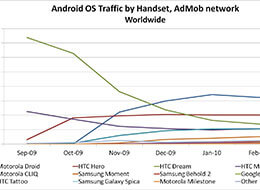Motorola Droid Is Androids Dominant Device
Mobile advertising network AdMob has released its metrics report for March 2010, taking a closer look at Google’s Android OS and its increasing share of the mobile market. The report also reveals that the Motorola Droid is the leading Android handset.
The number of Android devices available as of March 2010 is vastly greater than the number available just seven months ago. AdMob notes in its report that in September 2009, two devices — the HTC Dream (or G1) and the HTC Magic (the myTouch 3G) — accounted for 96% of all Android traffic. As of March 2010, 11 different devices accounted for 96% of Android traffic.
Check out this chart, which shows which Android devices are generating the largest amount of traffic:
 The Motorola Droid is the big winner, responsible for 32% of Android traffic in March 2010. Conversely, the Google Nexus One only generated 2% of Android traffic. Looking at the full data from AdMob’s report, it’s clear that although the operating system has really only made waves in the U.S., the Droid is the undisputed Android champion overall. To us, this speaks volumes about the power of Verizon’s network.
The Motorola Droid is the big winner, responsible for 32% of Android traffic in March 2010. Conversely, the Google Nexus One only generated 2% of Android traffic. Looking at the full data from AdMob’s report, it’s clear that although the operating system has really only made waves in the U.S., the Droid is the undisputed Android champion overall. To us, this speaks volumes about the power of Verizon’s network.
iPhone Still Leading the Pack
While Android’s market share is growing considerably, the iPhone and iPod touch remain the top two devices in AdMob’s report for March 2010. Furthermore, the iPhone accounts for 45.5% of all smartphone requests for March 2010. The closest competitor, the Motorola Droid, took in 8.2% of all requests.
 However, it’s important to note that even though the iPhone is still the smartphone and mobile device leader (even if you add up all other handsets collectively based on OS, iPhone is still in the lead), breakout successes on other platforms could easily change things.
However, it’s important to note that even though the iPhone is still the smartphone and mobile device leader (even if you add up all other handsets collectively based on OS, iPhone is still in the lead), breakout successes on other platforms could easily change things.
Android OS Fragmentation?
The Android platform is developing at a breakneck speed. In fact, it’s developing so quickly that there are phones coming to market still running older versions of the software, in large part because that was the version available when the devices went into deep testing.
This presents some hurdles for application developers who need to either make OS-specific versions or ensure backward compatibility across all major OS versions.
AdMob’s report shows that Android use is split across the three major releases of the platform: Android 1.5, Android 1.6 and Android 2.0/2.1. Android 1.5 has 38% marketshare — which makes sense, considering it is what most of the older Android devices still run — Android 2.0/2.1 has 35% of the market and Android 1.6 has 26%.
The problem for end-users is that the version of the OS you receive is largely dependent on the manufacturer of your phone and its relationship with your wireless carrier. Verizon Droid owners got Android 2.1 in the middle of last month, a relatively short wait for version upgrades. However, it’s not clear how long updates will take for the Droid or any other Android handset not manufactured in partnership with Google.











Even as I really like a physical keyboard, after managing the Samsung Captivate for approximately quarter-hour, it is arduous to move back. At this time I am debating whether to go to Verizon for the Droid X, cross to Dash for the EVO, or stick with AT&T for the Captivate…selections, decisions.